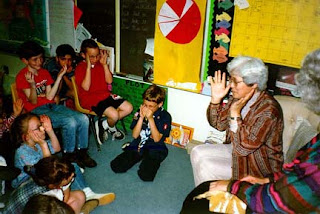STORY
TELLING –IMPORTANCE AND TIPS
Story Telling is one of the most interesting aspects of any
kindergarten. Stories fascinate everyone and play an important role in our
lives. Interest in various subjects is awakened through storytelling, and
children learn to identify with the feelings of others. Stories talk about
various places, different kinds of people of people, a lot of new words and new
pieces of information.
Stories can be real incident or figments of people's imagination.Even nature can be an abundant source of material for stories.The children not just enjoys these, but also learns various facts about nature from these.The story should be told in beautiful , simple and clear language.
Special Attention should be give to:
- The content of the story.
- Vocabulary used.
- Pronunciation of words.
- The tonal variations
- The expressions and gestures of the narrator.
Gather the children in front of you,either as a group sitting close to each other, or in several rows close to each other.No children should sit alongside or behind you and the nearest children should be about a foot away.
Sit on a low chair so that children in the back of the group
can see your face. The atmosphere should be very informal and cozy.
Story-telling is an art like dramatization.It involves Gesture,Voice- modulation, Volume fluctuation from low to high to higher to low.Tempo should be even , slow , quick, all these depending on the story.For eg: When describing a train, "The little train was so tired , it wen slowly trudging up the hill, slowly, slow--ly, slow--ly, slow----ly and at the ....eeeeeee----nd it reached the top of the hill and it stopped !!!" All through this , the narrator should accompany the story with very tired facial and body gestures.
Very important to "do" about story telling is to look at each child constantly moving your eyes from the nearest to the furthest and from extreme right to the extreme left.
No child should feel that is neglected because teacher did not "look" at him/her.Every child should feel that the story is being told directly to them.
A story can be a continuation of a conversation.We should not develop an artificial way of speaking while narrating stories.The language should be kept simple and clear.Try to use words that the child will understand.
Going back and forth in the sequences of incidents spoils the effect.The voice should be well modulated.
Conversations between characters should be how they would normally speak.Emphasis in the right places is very important to carry the import.The charm is added with tonal variations and facial movements of the story- teller.
Sometimes the children should tell stories to the whole class and to the teacher.This helps them to organize their thoughts and to be able to pick out the highlights and important points of a story.
Often give chances to the children to fill in the details or complete a sequence in a story by asking questions like, "Then what did the monkeys do?" the children will feel pride in being able to fill in such gaps by saying, The monkeys threw away......all the caps".This gives them a sense of participation.
In addition to the purposes of story-telling, showing pictures from a book while narrating or reading aloud from a book helps children to associate the spoken and written word.The come to realize that the little mark on the page have meaning, thus increasing their motivation for learning to read.
Hold the book high, opening it towards the children and "Not" towards you .Tell the story from memory , once in a while looking at it, or read it line by line. Stop to explain any new words. Pronunciation should be clear, well-spaced and with proper emphasis , and modulation of voice.
Story time need not be a fixed time or a time when everyone gathers around the circle. The time when children are waiting to be picked up by the parents or 15 minutes before dispersal can be a wonderful time for stories.
Tips For Teachers
In Kindergarten, story time is a serious activity.The adult has to prepare herself in the following manner before she proceeds to narrate a story.
- The teacher should have a good stock of carefully chosen stories,either copied from other sources or prepared of her own.
- It's a good idea to prepare a list of stories and write them in a note book for reference.In kindergarten, this will be useful for all the adults helping in that environment.
- The number of characters that play main roles should be limited.The child's simple mind will get confused and cluttered.
- The teacher has to prepare herself to narrate them like an actor rehearses before an appearance on stage.
- The teacher may even practice in front of mirrors to get the require effect.
- The adult must take special care not to laugh when children tell stories.This is very common occurrence in the child's world.Laughing at children undermines their self-esteem and we do more damage than good by laughing.Laugh "WITH" children not "AT" children.
- Tell the same story each day for at least a week. The younger
the child, the longer you can stick with the same story.
- You can make the story into a puppet show if you like and use
little dolls and props to set the scene, or you can just tell the story all
snuggled up on the couch.
You can also expand on the story through
other activities – drawing, dressing up and acting it out, painting from an
image, feeling, or mood from the story, modeling, or crafting. In the
kindergarten you can let your child learn through activity, imitation,
and play, and save intellectual exercises (such as answering questions,
recalling, or summarizing the story) .
*************************************












